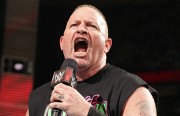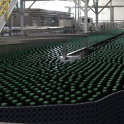|
I might have to try BB tabs as well. My cream ale is super overcarbed and now I'm worried about my saison doing the same.
|
|
|
|

|
| # ? Jun 6, 2024 23:44 |
|
fullroundaction posted:What I mean is a way to carbonate the bottles without using sugar (in tablet/pill form or through a solution) like a concentrated CO2 tablet or whatever so that things like temperature, yeast suspension, etc are not a factor. You can keg your beer, force carbonate it, and then bottle off of the keg.
|
|
|
|
Imasalmon posted:You can keg your beer, force carbonate it, and then bottle off of the keg. Whats the best way to do this? Use a picnic tap? A straight tube with a clip valve? I bottled before using sugar but if you can run it out of a keg I'd like to try it.
|
|
|
|
I saw a thread on HBT in which some guys successfully carbonated their beer in bottles by dropping three raisins in each bottle. http://www.homebrewtalk.com/f13/raisins-carbonation-358455/ Apparently this works, although you'd probably want to sanitized the outside since there are yeasts on raisin skins. I also saw a thread in which the guy successfully used dry ice in a PET bottle, but concluded it was highly dangerous and that you shouldn't do it.
|
|
|
|
Nateron posted:Whats the best way to do this? Use a picnic tap? A straight tube with a clip valve? I bottled before using sugar but if you can run it out of a keg I'd like to try it. The best way is a counter pressure bottle filler that let's you flush the bottle with co2 and achieve equal pressure between the bottle and the keg before beginning the fill. A very easy and only marginally less best way is to use a picnic ap, a bottling wand, and a stopper the size of the neck of the bottle (pretty sure it is a number 2). Run the bottling wand through the stopper, cram one end int the picnic tap, cram the other end into a bottle (ensuring a tight seal with the stopper), and open the tap all the way. When it stops filling (in my experiencing, about a third of the bottle), gently squeeze the stopper to release some of the pressure in the bottle so that it continues to fill. Pretty simple process.
|
|
|
|
Or the quick and dirty way if you're not bottling for long-term storage is just to drink draft beer when you're at home, and to use a tube jammed into the faucet to fill growlers when you are taking beer to a BBQ/party/whatever. And also, as I do a couple times a year, it's not terribly difficult to take a keg with you and pour off the keg if you need larger volumes than a growler or two for a party, Vegas weekend, camping, etc.
|
|
|
|
fullroundaction posted:Are there any force-carb tablets or something like that for bottling? I'd like have more consistency than I do with a priming solution but so far all I've seen out there are sugar pills. As I understand it, bottle conditioning will give you much finer bubbles and a smoother mouth feel than forced carbonation. That said, you can use pretty much anything that is designed to carbonate liquid. There are several OTC rigs designed for making seltzer water and such. your carbonation would be significantly harsher with these methods.
|
|
|
|
mbottoms posted:As I understand it, bottle conditioning will give you much finer bubbles and a smoother mouth feel than forced carbonation. That said, you can use pretty much anything that is designed to carbonate liquid. There are several OTC rigs designed for making seltzer water and such. your carbonation would be significantly harsher with these methods. I was under the impression that CO2 is CO2, and that things like "finer bubbles" was more or less subjective bullshit along the same lines as $1000 cables for audiophiles. Please note I'm not trying to attack you or anything mbottoms.
|
|
|
|
B4TBG, I agree with you. A higher level of carbonation will give larger bubbles as more gas will come out of solution in a given time, but I've had plenty of primed and force-carbonated beer with no discernable difference between them. Chemically, CO2 is CO2 is CO2 and there's no reason to expect it to behave differently based on how it was added to the beer/wine/cider.
|
|
|
|
Beer4TheBeerGod posted:I was under the impression that CO2 is CO2, and that things like "finer bubbles" was more or less subjective bullshit along the same lines as $1000 cables for audiophiles. I'm 100% with you on the platinum and gold laced spidersilk insulated mega hdmi cables. That's some bullshit. I'm talking about the difference in bubbliness between champagne, a thick brown ale, coca-cola, and your average amuriken lager. All CO2, all slightly different feeling on your tongue. edit: quick googling for citing sources. http://thankheavenforbeer.com/2010/03/22/natural-carbonation-vs-forced-carbonation/ There is a marked difference. The force carbonated beer looks better. The bottom of the bottle boasts no sediment, and the beer pours crystal clear. It looks like it was pulled right out of a sixpack from your typical craft brewery. It pours with a decent head and bubbles cling to the inside of the glass. Lacing is minimal. The beer carbonated ye old naturale method has a thin layer of yeast on the bottom. The head is thicker and more billowy with more peaks and valleys, and it has longer retention with more lacing. There are fewer bubbles sticking to the glass (both dishwasher cleaned) and the bubbles are tinier. In the mouth, the beer feels smoother than the force carbonated beer, and more effervescent; perhaps more champagne like, though both feel as they have the same level of carbonation. The beer that was carbonated induces more belching. Flavor? Yes, there is a difference. http://www.ratebeer.com/forums/force-carbonation-vs-bottle-conditioning_120682.htm some interesting back and forth eith both the for and against positions. Note: Nobody disputes that there is a tangible difference of texture, taste and clarity. The argument seems to be about which is subjectively 'better'. mbottoms fucked around with this message at 21:52 on Dec 19, 2012 |
|
|
|
I made a yeast starter last Thursday-Friday in anticipation for brewing this past weekend, however all of my primary vessels are running behind schedule and weren't able to rack into secondary. They are still going today and I'm worried the yeast starter (which has been sitting in my fridge since Friday night) is losing it's viability fast. What's my threshold for this starter sitting in my fridge? Should I just pony up for a fourth carboy since it looks like these other beers won't be ready to rack for another 5 days or so?
|
|
|
|
mbottoms posted:<stuff> But none of that has to do with the statement that started the discussion: mbottoms posted:As I understand it, bottle conditioning will give you much finer bubbles and a smoother mouth feel than forced carbonation. It stands to reason that yeast will do other stuff than produce CO2 and ETOH, and that of course there will be differences in sediment, clarity, etc., but carbonation levels are what give the soft vs. prickly mouthfeel, bubble size, etc. I've often noticed (as right now with a cider I just put to carbonate) that the carbonation changes over time, from fine, barely-visible bubbles and no perceptible prickle in the mouth early in the process, to large bubbles, gushing head, and carbonic acid sourness when my regulator is maladjusted.
|
|
|
|
Jo3sh posted:But none of that has to do with the statement that started the discussion: Sure it does. It's a number of different sources saying things very similar to my initial statement. Specifically, that bottle conditioned beers differ substantially from force carbonated beers. Among the differences cited is finer carbonation and smoother texture. Jo3sh posted:It stands to reason that yeast will do other stuff than produce CO2 and ETOH, and that of course there will be differences in sediment, clarity, etc., but carbonation levels are what give the soft vs. prickly mouthfeel, bubble size, etc. That's an interesting and relevant anecdote. I do intend to play with forced carbonation later in my brewing career. It'll be interesting to do some testing on the subject. Admittedly, I'm a serious n00b, my first 2 batches are not yet ready to drink. I have read that the slower release of CO2 over time during bottle conditioning results in the slower absorption of CO2 by the liquid and therefore, smaller bubbles. If I'm mistaken, which is entirely possible, than it is at the very least a common misconception. edit: pretty sure that Sam Calagione also said this on an episode of Brewmasters. mbottoms fucked around with this message at 22:56 on Dec 19, 2012 |
|
|
|
mbottoms posted:Sure it does. It's a number of different sources saying things very similar to my initial statement. Specifically, that bottle conditioned beers differ substantially from force carbonated beers. Among the differences cited is finer carbonation and smoother texture. Taste is far more about what someone thinks than what may actually be there. How CO2 dissolves does not affect how it comes out of solution or tastes or feels. There is really no mechanism for it outside of preconceived notions affecting taste. Everyone is good on phase change with water so let's use that example. Does it affect the size of the bubbles in a boiling pot of water whether it condensed fast or slow?
|
|
|
|
zedprime posted:Taste is far more about what someone thinks than what may actually be there. However, alterations to the chemical composition (viscosity, head-related chemicals, etc.) caused by the further action of added yeast during bottle conditioning could conceivably influence the size of the bubbles.
|
|
|
|
Cream_Filling posted:However, alterations to the chemical composition (viscosity, head-related chemicals, etc.) caused by the further action of added yeast during bottle conditioning could conceivably influence the size of the bubbles. That's the saner argument but 3 oz of sugars worth of fermentation is really iffy in what it could actually affect.
|
|
|
|
zedprime posted:That's the saner argument but 3 oz of sugars worth of fermentation is really iffy in what it could actually affect. I can see it having something to do with yeast in the bottle and glass giving more nucleation points or something. But homebrewed kegged beer is generally not filtered, and I've poured hazy pints and even downright mucky ones. I just had a beer that had a yeast flavor I didn't care for, but the (force) carbonation was just fine. Also, this: zedprime posted:Taste is far more about what someone thinks than what may actually be there. BA and RateBeer are full of "force carbonated, so it had a heavy mouthfeel" and similar comments. I don't buy it, personally, but I'm willing to stipulate that some others do experience it, whatever the source of that experience. Long story short, brew what you like, as you prefer. Drink that way also.
|
|
|
|
mbottoms posted:I'm talking about the difference in bubbliness between champagne, a thick brown ale, coca-cola, and your average amuriken lager. All CO2, all slightly different feeling on your tongue. I'd argue that the difference is the amount of carbonation, not the quality. Of course champagne or soda feels fizzier and harsher on your tongue--there's like 4x the amount of CO2 dissolved in there compared to a typical brown ale. The blog post you link is interesting, but it's just one random dude. Who's to say he's meticulous enough to actually brew two batches exactly the same as he claims? Maybe he accidentally mashed the bottle conditioned beer 3 degrees higher or measured the grain bill wrong and put more carapils/wheat/whatever in? Were the beers the exact same age and temperature when served? Why not do a blind test to rule out his bias in favor of bottle conditioning? Definitely not trying to call you out either, it's an interesting discussion.
|
|
|
|
Jo3sh posted:I can see it having something to do with yeast in the bottle and glass giving more nucleation points or something. But homebrewed kegged beer is generally not filtered, and I've poured hazy pints and even downright mucky ones. I just had a beer that had a yeast flavor I didn't care for, but the (force) carbonation was just fine. I have an alternate theory that people say force carbonated beer has a heavier mouthfeel because many homebrews have lower carbonation levels. There's simply no reason CO2 would manifest in some different form - its a molecule. Docjowles posted:I'd argue that the difference is the amount of carbonation, not the quality. Of course champagne or soda feels fizzier and harsher on your tongue--there's like 4x the amount of CO2 dissolved in there compared to a typical brown ale. Angry Grimace fucked around with this message at 00:58 on Dec 20, 2012 |
|
|
|
Angry Grimace posted:its a molecule. I saw someone somewhere as I was looking around today say that he didn't care if CO2 was CO2 was CO2, he was convinced there was a difference at a "sub-molecular" level. So apparently it's the quarks.
|
|
|
|
Jo3sh posted:I saw someone somewhere as I was looking around today say that he didn't care if CO2 was CO2 was CO2, he was convinced there was a difference at a "sub-molecular" level. So apparently it's the quarks. I've got a force-bosonator I could part with if he wants it...
|
|
|
|
I think that individual may be retarded.
|
|
|
|
Paladine_PSoT posted:I've got a force-bosonator I could part with if he wants it... Ew, it's got... HIGGS all over it.
|
|
|
|
Thanks everyone for the advice about the lager. Unfortunately I dont have a kegerator, or the time at the moment to rig up some chilling/heating device. Though I'd be regressing, I'm thinking about buying another cooper kit, using LME instead of dextrose, and then just using the coopers yeast so I can brew at room temperature. It wont be as good, but my time is limited at the moment and the pre-hopped extract will save me an hour of boiling. Truthfully I'm less of a beer connaisseur, and more of a guy who likes to get drunk on the cheap. Though the ability to brew lagers would be nice. Ales are fun but I could go for something with a bit less of a fruity taste for a bit.
|
|
|
|
Les Oeufs posted:Thanks everyone for the advice about the lager. Unfortunately I dont have a kegerator, or the time at the moment to rig up some chilling/heating device. Though I'd be regressing, I'm thinking about buying another cooper kit, using LME instead of dextrose, and then just using the coopers yeast so I can brew at room temperature. Extract brewing is never cheaper than just buying a 30 of Miller Lite.
|
|
|
|
Les Oeufs posted:Thanks everyone for the advice about the lager. Unfortunately I dont have a kegerator, or the time at the moment to rig up some chilling/heating device. Though I'd be regressing, I'm thinking about buying another cooper kit, using LME instead of dextrose, and then just using the coopers yeast so I can brew at room temperature. Hey man, if you can't temp control right now, but maybe might in the future, and like lagers, two really decent ale kits you can brew at household temps are Northern Brewer's Cream Ale kit or their California Common. They're pretty cheap and though a bit heavier than a normal pilsener, will probably be pretty close to what you prefer and cheaper than most ale kits.
|
|
|
|
Jo3sh posted:I saw someone somewhere as I was looking around today say that he didn't care if CO2 was CO2 was CO2, he was convinced there was a difference at a "sub-molecular" level. So apparently it's the quarks. Ah yes, the homeopathic argument. The CO2 "remembers" where it's been, just like water remembers being mixed with toxic chemicals before being diluted like a billion times.
|
|
|
|
So I pulled a bottle from the cider with champagne yeast the other day. Used cooper's tabs (4 in each), and it was just as flat as when I bottled. Drat. Would it be because it's maltose or something instead of more simple sugars? It is ~10% abv, would the 'normal' two week window not be enough? I also bottled the dry hopped and bourbon oak version with Piloncillo because I was running low on tabs - we'll see how/if those come out to conclude on the sugar structures I guess.
|
|
|
|
I'm really far out of my depth here, but even though that guy was wrong about CO2, there is the concept of chirality which basically says you can have two molecules that are composed of the exact same atomic elements that are completely different from one another, the only difference being that one is the mirror image of the other. A popular example being the molecule that gives caraway seeds their smell can be mirror-imaged to make the molecule that makes spearmint gum smell the way it does.
|
|
|
|
RiggenBlaque posted:I'm really far out of my depth here, but even though that guy was wrong about CO2, there is the concept of chirality which basically says you can have two molecules that are composed of the exact same atomic elements that are completely different from one another, the only difference being that one is the mirror image of the other. A popular example being the molecule that gives caraway seeds their smell can be mirror-imaged to make the molecule that makes spearmint gum smell the way it does. Eh, I'm not buying it because chirality in the end is describing real structural and thereby chemical differences. You could instead argue that the makeup of gas produced by yeast is not pure CO2 and is combined with other gaseous byproducts, or else that pressurized CO2 has a different gas mix of stuff other than pure CO2. For instance, nitrogen is far less soluble in water and thus produces significantly smaller bubbles when used in beer. This is a wild guess, though, as I bet this already pretty well studied (I know little about the actual science of brewing beyond basic science knowledge), but at the same time, organic processes are pretty unpredictable and 'messy,' and mostly pure gasses from a tank often aren't as pure as we think. But, again, this is a total Scientific Wild-rear end Guess.
|
|
|
|
Jacobey000 posted:So I pulled a bottle from the cider with champagne yeast the other day. Used cooper's tabs (4 in each), and it was just as flat as when I bottled. Drat. Would it be because it's maltose or something instead of more simple sugars? It is ~10% abv, would the 'normal' two week window not be enough? A while back I made an IIPA at about 9.5% and it took a good 3 to 4 weeks to carb up properly. I think it's just more work for the yeast in a higher ABV solution.
|
|
|
|
As a professional bottler/kegger of beer CO2 is CO2. If you split a batch between force carbing and bottle conditioning I highly doubt anyone would be able to tell the difference in a blind triangle tasting if all other factors (temp, amount of dissolved CO2, etc.) were the same. There are advantages to bottle conditioning such as the yeast scavenging oxygen over time which may make it more desirable, but the CO2 being different isn't one of them.
|
|
|
|
.
almost fucked around with this message at 11:02 on Dec 15, 2013 |
|
|
|
Cream_Filling posted:Eh, I'm not buying it because chirality in the end is describing real structural and thereby chemical differences. Pretty much. Chirality and isomerism are kind of only a thing because of a mental propensity to cheat and lump things together when there is a light pattern, depending how philosophical you get about your chemistry. Also funny cases when one is more stable than the other when you aren't looking like thalidomide. There are no stable isomers and CO2 is not chiral for the record but it sounds like we knew that starting this conversation.
|
|
|
|
.
almost fucked around with this message at 11:02 on Dec 15, 2013 |
|
|
|
almost posted:So what kind of useful spreadsheets do you guys have set up? Here's what I have so far to make things easier.
|
|
|
|
.
almost fucked around with this message at 11:01 on Dec 15, 2013 |
|
|
|
Sure. There are always 4 quarts or 8 pints in a gallon. The Imperial ounce is slightly smaller than the US ounce, but the Imperial pint has 20 Imperial ounces in it, making it something like 19 US ounces. The UK/Imperial gallon is 160 (8 pints at 20 ounces) Imperial ounces.
|
|
|
|
almost posted:So what kind of useful spreadsheets do you guys have set up? Here's what I have so far to make things easier. I use brewersfriend.com to calc my recipes and avoid paying by keeping my stored recipes in various text files. I'm also checking out Brewsmith, which seems very robust but a little less easy to use.
|
|
|
|

|
| # ? Jun 6, 2024 23:44 |
|
hellfaucet posted:Hey man, if you can't temp control right now, but maybe might in the future, and like lagers, two really decent ale kits you can brew at household temps are Northern Brewer's Cream Ale kit or their California Common. They're pretty cheap and though a bit heavier than a normal pilsener, will probably be pretty close to what you prefer and cheaper than most ale kits. Those both sound awesome, but alas, I am Canadian. The shipping charges get prohibitively expensive. So whats the cheapest way a guy could get some temp control gear going? I can proudly say that I broke even on the beer making hobby on the last batch. I cant tell if I want to keep out of the hole for a while, or have something new to pay off in savings.
|
|
|



























